Tis the season for chapped hands! As a Denver transplant from Arizona, wearing gloves regularly has been a hard habit for me to make and I often find myself regretting not putting more effort into covering my hands when I go out. And truth be told, I enjoy wearing gloves. But I’m glad it is optional as well. In Victorian times the use of gloves grew increasingly mandated before falling into the “classy choice option” that they would become in the Jazz age and beyond.
Victorians loved their codes of conduct. Gloves in particular were expected to be used in specific ways, but always used. I have done a bit of digging into the etiquette rules and social expectations surrounding gloves in the mid to late 19th century and some of them may surprise you. It may also surprise you that one of our reader’s favorite period dramas got it wrong a lot of the time! Read on for the details.
Going out? What gloves to wear
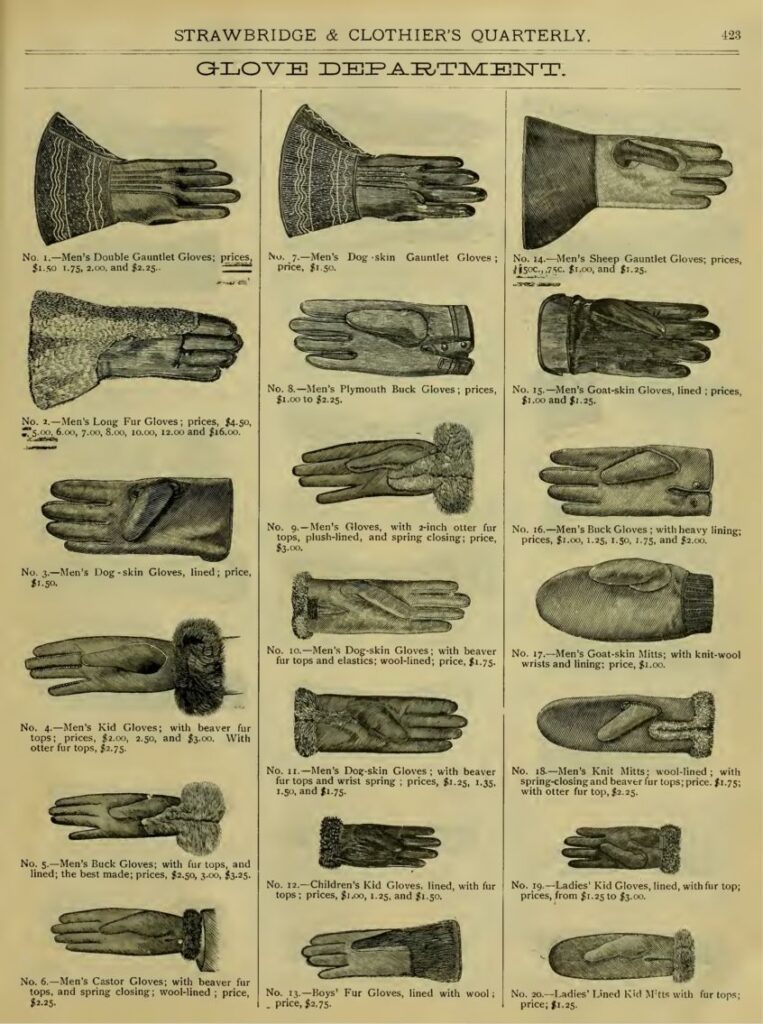
A woman of any social class would have owned many pairs of gloves during the Victorian period. While today we may think that wearing gloves for any occasion may feel like being a bit dressed up, that wasn’t the case at the time. Instead, wearing gloves in public was seen as being as mandatory as wearing shoes, and different gloves were available for casual and formal settings.
Gloves were not required or expected inside of one’s own home when not entertaining. In a society with such strict rules, this is something that would have been seen as odd behavior. But if one did venture into public, gloves were on. And how to select which pair to wear? Here are some basics
Daywear: errands, and visits
The standard daytime glove during the Victorian era was the “kid” glove, with “kid” being the type of leather used (I used to think “kid” referred to the length of the glove, but I was wrong!). Says the 1860’s Lady’s Book of Etiquette:
“Never go out without gloves; put them on before you leave the house. You should no more be seen puling on your gloves in the street than tying the strings of your bonnet. Your gloves should always be of kid: silk or cotton gloves are very vulgar.” (Lady’s Book of Etiquette, 1860)
Well, there you go!
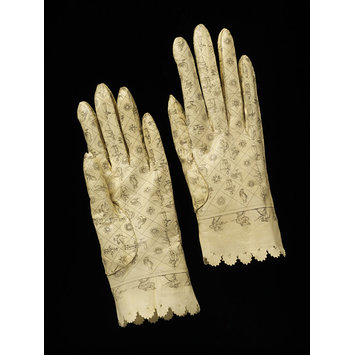
Image source: V&A.org
Daytime gloves were short, just extending to the wrist, and often of pale colors. Started to extend toward the elbow in later Victorian era. In the early Victorian era such gloves may have had a ribboned top, but this fell out of fashion by the mid-1800s. The embellishments most often found were lovely embroidered flowers. Swoon.
As I will come back to, it is important to remember that such gloves were worn for purposes of modesty rather than comfort/weather. And while some may imagine such things being worn on a hot summer day as incredibly unbearable, keep in mind that a lot of the fabrics of the time, including kid leather, were far more breathable than those we use in clothing today.
Evening socializing
Following in the fashion of the wrist-to-below-elbow styles of day gloves, up until the 1860s evening gloves followed the same rules. Then, we see them increasing in inches with each passing year. By 1880 we see evening gloves extending even beyond the elbow, sometimes with 20 buttons to fasten.
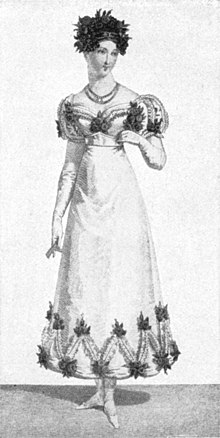
“With regard to dress itself, the first things a lady ought to think about are her gloves and shoes; for spoiled or ripped gloves, or shabby boots, will destroy the effect of the most elegant gown ever worn…The gloves should in a degree match, or at least harmonize, with the dress; and if a young lady’s allowance does not permit her to have a large stock of different colours, she will do her well to select those soft neutral tints which will suit any dress: the delicate greys, and fawn or dove-colours for summer; the soft brown or invisible green for winter wear.” (Lady’s Book of Etiquette, 1860)
Evening gloves were also embroidered in the early Victorian era but then tended to be embellished with lace inserts, if at all. And while many may think of evening gloves as being made of silk or satin, they were most typically made of kid and other animal skins. Silk gloves were popular in the 1880s, but were seen as a bit tacky by the 1890s: “Silk gloves have long ceased to be fashionable though thousands of women wear them” (Woman’s World, 1888).
You know what gloves to wear and when, but there is a lot more to it than just selecting and putting them on. Things get particularly complicated at evening functions. Let’s take a look, shall we?
Gloves at the dinner table
Those attending a dinner party would all be expected to wear gloves up until the start of being served. Then, according to the Lady’s Book of Etiquette:
“When seated, take off your gloves and put them on your lap. Before you, on your plate, will be a table-napkin, with a dinner roll on it; take the bread out and put it at the side of your plate. Put the table-napkin in your lap, on your gloves, and then listen gracefully, and with attention, to your companion, who will do his best to amuse you whilst the soup is being handed round.”
I do love that the advice about removing one’s gloves and listening gracefully to the host as the soup is served goes hand in hand.
The cleanliness of gloves was something that I saw appear repeatedly in the manuals I used for this post. In a way, it made me think of the attention given today to washing one’s face mask daily! So important was the cleanliness of gloves that ensuring one’s hands were suitable for one’s gloves was inserted into the dinner ritual:
“When you have finished your fruit or nuts, dip the tips of your fingers daintily into your finger glass, and dry them in your table-napkin; then pull on your gloves quietly and slowly, keeping your hands while you do so a little below the table.” (Lady’s Book of Etiquette, 1860)
What stands out to you about the glove-removing etiquette thus far? I am amused by the fact that after eating her dinner sans-gloves, a woman would have been expected to so subtlety put them back on underneath the table. Oh, Victorians!
Sidebar: film depictions of Victorian gloves
The rules for removing one’s gloves before eating applied also to drinking cocktails whilst seated and having tea. SO…here’s a conversation starter for you (or a way to irritate people when watching period dramas): a LOT of the portrayals that we see of gloves in film are highly incorrect. Same with the wearing of hats, throw out what you have seen in movies! While characters portrayed on film may wear both indoors or while dining, this is meant to add a timely flavor to the piece and does not reflect the standards of the time or habits that one should follow even today. Even the highly researched and marvelously costumed Downtown Abby has scenes in which gloves are worn at inappropriate times (though of course, that is an Edwardian piece, not Victorian, but the same rules applied).
The website Etiquimedia has a list of glove etiquette violations in film. They refer to Downtown Abby as a “repeat offender.” It’s a delight, take a look here.
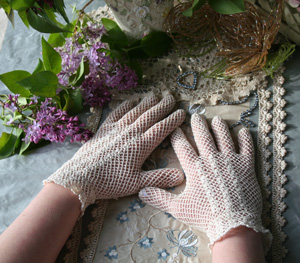
You know the rules, now create a look of your own!
Fingerless Black Velvet Opera Gloves
Love learning about Victorian fashion? Check out these posts:
A short history of the hand muff: history’s cutest accessory

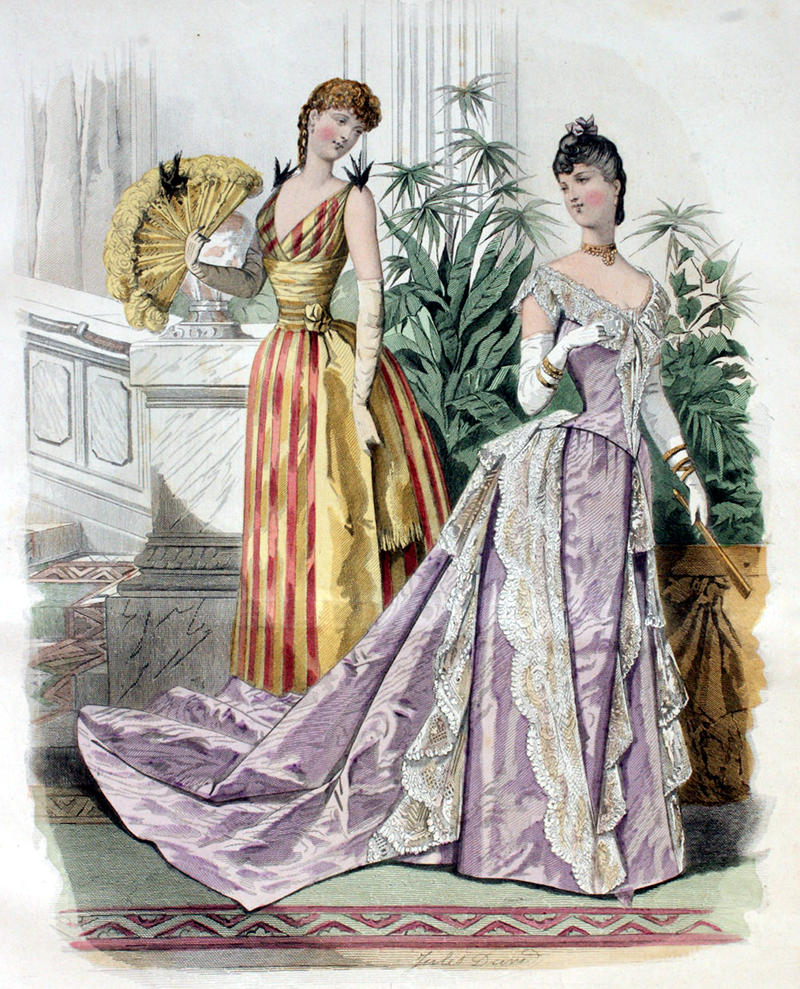












Hi Sofia, so glad you liked this!
Wow what an interesting article! this is so cool thanks :))